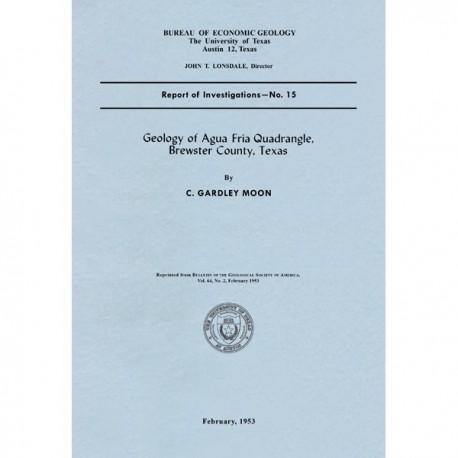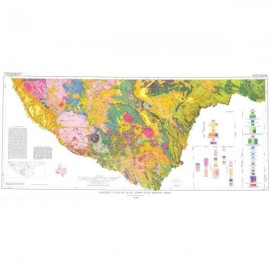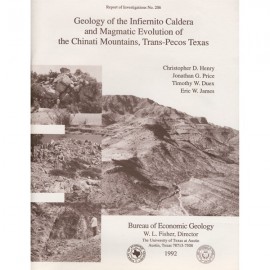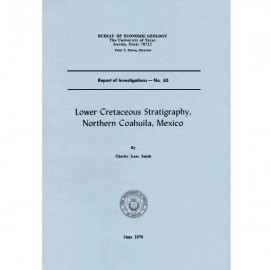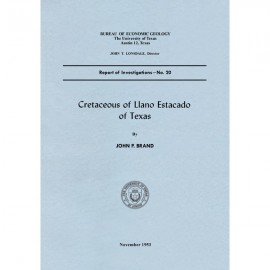Reports of Investigations
-
Books & Reports
- Reports of Investigations
- Guidebooks
- Udden Series
- Geological Circulars
- Down To Earth
- Atlases of Major Oil and Gas Reservoirs
- Texas Memorial Museum Publications
- Environmental Geologic Atlas of the Texas Coastal Zone
- Mineral Resource Circulars
- Other Reports
- Seminars and Workshops
- Handbooks
- Submerged Lands of Texas
- Symposia
- Annual Reports
- Open File Reports
-
Maps & Cross Sections
- Thematic Maps
- Miscellaneous Maps, Charts & Sections
- Geologic Atlas of Texas
- STATEMAP Project Maps
- Geologic Quadrangle Maps
- Cross Sections
- Highway Geology Map
- Energy and Mineral Resource Maps
- Shoreline Change and Other Posters
- Wilcox Group, East Texas, Geological / Hydrological Folios
- Bouguer Gravity Atlas of Texas
- River Basin Regional Studies
- Featured Maps
- Posters
- Teachers & the Public
-
Geological Society Publications
- Gulf Coast Association of Geological Societies
- Alabama Geological Society
- Austin Geological Society
- Corpus Christi Geological Society
- Houston Geological Society
- Lafayette Geological Society
- Mississippi Geological Society
- New Orleans Geological Society
- South Texas Geological Society
- GCS SEPM Publications
- Historic BEG & UT Series
Geology of Agua Fria Quadrangle, Brewster County, Texas
RI0015
Geology of Agua Fria Quadrangle, Brewster County, Texas, by C. G. Moon. 45 p., 4 figs., 1 map, 5 pls. Reprinted from Geological Society of America Bulletin, v. 64, no. 2, 1953. Print Version.
A free, digital version of this publication can be found on: Texas ScholarWorks
This product is no longer in stock
RI0015. Geology of Agua Fria Quadrangle, Brewster County, Texas, by C. G. Moon. 45 p., 4 figs., 1 map, 5 pls. Reprinted from Geological Society of America Bulletin, v. 64, no. 2, 1953.
To purchase this publication as a downloadable PDF, please order RI0015D.
To purchase a blueline copy of the map only, please order MM0001.
ABSTRACT
The 15-minute Agua Fria quadrangle in southwestern Brewster County, Texas, is arid, sparsely vegetated, and includes diverse topographic features that result chiefly from complex structure and variation in rock resistance to erosion. The mountainous and more complicated southern part of the area has suffered much deformation by igneous intrusions and faulting.
The Comanche series is represented by the Devils River limestone, Grayson marl, and Buda limestone. A disconformity separates it from the overlying gradational Gulf series which consists of the Boquillas,Terlingua, and Aguja formations. Because the Boquillas-Terlingua boundary problem is critical and unsettled, lithologic members and paleontologic zones in that section are described in considerable detail. A distinctive 50-foot rock unit, herein named the Fizzle Flat lentil, occurs about the middle of the Boquillas-Terlingua sequence. A widespread angular unconformity separates the Gulf series from the Tertiary Buck Hill volcanic series. Quaternary terrace gravels occur at different levels, and other alluvial deposits have been mapped.
The Tertiary hypabyssal igneous rocks are alkalic and form stocks, laccoliths, plugs, sills, dikes, and bysmaliths or trap-door domes. Several lava flows are preserved in the southwest part of the quadrangle. Metamorphic effects generally are slight.
The area is part of the Big Bend sunken block. Except where influenced by intrusive masses, a pattern of northwesterly normal faults establishes the structural trend of the area. Step faults are common. Most of the major faults are downthrown to the southwest with the huge intervening blocks tilted gently to the northeast. That much of the fault pattern was established during the Laramide revolution and that faulting recurred along the old lines of weakness fairly late in Tertiary time are postulated.
Keywords: Agua Fria, Boquillas, Brewster County, Terlingua, Texas
CONTENTS
Introduction
Field work
Acknowledgments
Previous work
Physiography
Stratigraphy
Stratigraphic units
Comanche series
Devils River limestone
Grayson (Del Rio) marl
Buda limestone
Gulf series
Tentative correlation
The Boquillas-Terlingua problem
Lower Boquillas-Terlingua unit
Upper Boquillas-Terlingua unit
Aguja formation
Tertiary
General description
Buck Hill volcanic series
Quaternary
General description
Gravel
Alluvium
Intrusive igneous rocks
Introduction
Trap-door domes
Stocks, laccoliths, bysmaliths, plugs, etc.
Sills
Dikes
Metamorphic effects
Igneous petrography
Structural geology
General description
Normal faults
Domes
Geologic history
Economic geology
References cited
Figures
1. Index map of the southern part of Trans-Pecos Texas
2. Correlation of Gulf series in Agua Fria quadrangle
3. Trap-door dome, Gray Hill, and domical uplift, Packsaddle Mountain
4. Structural setting of the Agua Fria quadrangle
Plates
1. Geologic map and structure sections of Agua Fria quadrangle, Texas
2. Boquillas-Terlingua sequence
3. Tuffs and topographic forms
4. Buck Hill volcanic series
Tables
1. Petrography of the igneous rocks of the Agua Fria quadrangle, Texas
2. Estimated stratigraphic throw of several major faults
Citation
Moon, C. G., 1953, Geology of Agua Fria Quadrangle, Brewster County, Texas: The University of Texas at Austin, Bureau of Economic Geology, Report of Investigations No. 15, 45 p.
